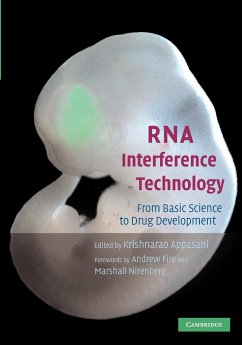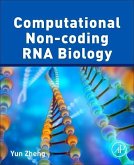RNA Interference Technology
From Basic Science to Drug Development
Herausgeber: Appasani, Krishnarao
RNA Interference Technology
From Basic Science to Drug Development
Herausgeber: Appasani, Krishnarao
- Broschiertes Buch
- Merkliste
- Auf die Merkliste
- Bewerten Bewerten
- Teilen
- Produkt teilen
- Produkterinnerung
- Produkterinnerung
This book provides an overview of RNA interference (RNAi) technology, covering both fundamental science and applications.
Andere Kunden interessierten sich auch für
![Dna-Rna Research for Health and Happiness Dna-Rna Research for Health and Happiness]() Jose DortaDna-Rna Research for Health and Happiness15,99 €
Jose DortaDna-Rna Research for Health and Happiness15,99 €![Computational Non-Coding RNA Biology Computational Non-Coding RNA Biology]() Yun ZhengComputational Non-Coding RNA Biology151,99 €
Yun ZhengComputational Non-Coding RNA Biology151,99 €![Elemente der exakten Erblichkeitslehre Elemente der exakten Erblichkeitslehre]() Wilhelm JohannsenElemente der exakten Erblichkeitslehre48,99 €
Wilhelm JohannsenElemente der exakten Erblichkeitslehre48,99 €![Cytokinesis in Animal Cells Cytokinesis in Animal Cells]() R. RappaportCytokinesis in Animal Cells63,99 €
R. RappaportCytokinesis in Animal Cells63,99 €![Genetic Variation and Human Disease Genetic Variation and Human Disease]() Csba WeissGenetic Variation and Human Disease55,99 €
Csba WeissGenetic Variation and Human Disease55,99 €![The Production of New Potato Varieties The Production of New Potato Varieties]() The Production of New Potato Varieties61,99 €
The Production of New Potato Varieties61,99 €![DNA Microarrays and Gene Expression DNA Microarrays and Gene Expression]() Pierre BaldiDNA Microarrays and Gene Expression44,99 €
Pierre BaldiDNA Microarrays and Gene Expression44,99 €-
-
-
This book provides an overview of RNA interference (RNAi) technology, covering both fundamental science and applications.
Hinweis: Dieser Artikel kann nur an eine deutsche Lieferadresse ausgeliefert werden.
Hinweis: Dieser Artikel kann nur an eine deutsche Lieferadresse ausgeliefert werden.
Produktdetails
- Produktdetails
- Verlag: Cambridge University Press
- Seitenzahl: 546
- Erscheinungstermin: 26. Mai 2011
- Englisch
- Abmessung: 254mm x 178mm x 29mm
- Gewicht: 1014g
- ISBN-13: 9780521205177
- ISBN-10: 0521205174
- Artikelnr.: 32465330
- Herstellerkennzeichnung
- Libri GmbH
- Europaallee 1
- 36244 Bad Hersfeld
- gpsr@libri.de
- Verlag: Cambridge University Press
- Seitenzahl: 546
- Erscheinungstermin: 26. Mai 2011
- Englisch
- Abmessung: 254mm x 178mm x 29mm
- Gewicht: 1014g
- ISBN-13: 9780521205177
- ISBN-10: 0521205174
- Artikelnr.: 32465330
- Herstellerkennzeichnung
- Libri GmbH
- Europaallee 1
- 36244 Bad Hersfeld
- gpsr@libri.de
Part I. Basic RNAi, siRNA and Gene Silencing Mechanisms: 1. RNAi beginnings: overview of the pathway in C. elegans
2. Dicer in RNAi: its roles in vivo and utility in vitro
3. Genes required for RNAi
4. MicroRNAs: a small contribution from worms
5. miRNAs in the brain and the application of RNAi to neurons
Part II. Design and Synthesis of siRNAs: 6. Design and synthesis of small interfering RNA (siRNA)
7. Automated design and high throughput synthesis of siRNA
8. Rational design of siRNAs with the Sfold software
9. Enzymatic production of siRNAS
Part III. Vector Development and In Vivo, In Vitro and In Ovo Delivery Methods: 10. Six methods of inducing RNAi in mammalian cells
11. Viral delivery of siRNA
12. siRNA delivery by lentiviral vectors: design and applications
13. Liposomal delivery of siRNAs in mice
14. Chemical modifications to achieve increased stability and sensitive detection of siRNA
15. RNAi in postimplantation mouse embryos
16. In ovo RNAi opens new possibilities for functional genomics in vertebrates
Part IV. Gene Silencing in Model Organisms: 17. Practical applications of RNAi in C. elegans
18. Inducible RNAi as a forward genetic tool in Trypanosoma brucei
19. RNAi gene silencing in yeast
20. RNA silencing in filamentous fungi: Mucor circinelloides as a model organism
21. RNAi and gene silencing phenomenon mediated by viral suppressors in plants
Part V. Drug Target Validation: 22. Delivering siRNA in vivo for functional genomics and novel therapeutics
23. The role of RNAi in drug target validation: application to Hepatitis C
24. RNAi in the drug discovery process
25. RNAi: use in the drug discovery process
Part VI. Therapeutic and Drug Development: 26. RNAi-mediated silencing of viral gene expression and replication
27. RNAi in drug development: practical considerations
28. RNAi for the treatment of liver diseases
29. RNAi applications in animal systems
Part VII. Genome Wide RNAi and High Through-Put Analysis: 30. High through-put RNAi-by-soaking in Caenorhabditis elegans
31. Tools for integrative genomics: genome-Wide RNAi and expression profiling in Drosophila
32. Microarray analysis and RNA silencing to determine genes functionally important in Mesothelioma
33. High through-put RNAi
34. Generation of highly specific vector-based shRNAi libraries directed against the entire human genome.
2. Dicer in RNAi: its roles in vivo and utility in vitro
3. Genes required for RNAi
4. MicroRNAs: a small contribution from worms
5. miRNAs in the brain and the application of RNAi to neurons
Part II. Design and Synthesis of siRNAs: 6. Design and synthesis of small interfering RNA (siRNA)
7. Automated design and high throughput synthesis of siRNA
8. Rational design of siRNAs with the Sfold software
9. Enzymatic production of siRNAS
Part III. Vector Development and In Vivo, In Vitro and In Ovo Delivery Methods: 10. Six methods of inducing RNAi in mammalian cells
11. Viral delivery of siRNA
12. siRNA delivery by lentiviral vectors: design and applications
13. Liposomal delivery of siRNAs in mice
14. Chemical modifications to achieve increased stability and sensitive detection of siRNA
15. RNAi in postimplantation mouse embryos
16. In ovo RNAi opens new possibilities for functional genomics in vertebrates
Part IV. Gene Silencing in Model Organisms: 17. Practical applications of RNAi in C. elegans
18. Inducible RNAi as a forward genetic tool in Trypanosoma brucei
19. RNAi gene silencing in yeast
20. RNA silencing in filamentous fungi: Mucor circinelloides as a model organism
21. RNAi and gene silencing phenomenon mediated by viral suppressors in plants
Part V. Drug Target Validation: 22. Delivering siRNA in vivo for functional genomics and novel therapeutics
23. The role of RNAi in drug target validation: application to Hepatitis C
24. RNAi in the drug discovery process
25. RNAi: use in the drug discovery process
Part VI. Therapeutic and Drug Development: 26. RNAi-mediated silencing of viral gene expression and replication
27. RNAi in drug development: practical considerations
28. RNAi for the treatment of liver diseases
29. RNAi applications in animal systems
Part VII. Genome Wide RNAi and High Through-Put Analysis: 30. High through-put RNAi-by-soaking in Caenorhabditis elegans
31. Tools for integrative genomics: genome-Wide RNAi and expression profiling in Drosophila
32. Microarray analysis and RNA silencing to determine genes functionally important in Mesothelioma
33. High through-put RNAi
34. Generation of highly specific vector-based shRNAi libraries directed against the entire human genome.
Part I. Basic RNAi, siRNA and Gene Silencing Mechanisms: 1. RNAi beginnings: overview of the pathway in C. elegans
2. Dicer in RNAi: its roles in vivo and utility in vitro
3. Genes required for RNAi
4. MicroRNAs: a small contribution from worms
5. miRNAs in the brain and the application of RNAi to neurons
Part II. Design and Synthesis of siRNAs: 6. Design and synthesis of small interfering RNA (siRNA)
7. Automated design and high throughput synthesis of siRNA
8. Rational design of siRNAs with the Sfold software
9. Enzymatic production of siRNAS
Part III. Vector Development and In Vivo, In Vitro and In Ovo Delivery Methods: 10. Six methods of inducing RNAi in mammalian cells
11. Viral delivery of siRNA
12. siRNA delivery by lentiviral vectors: design and applications
13. Liposomal delivery of siRNAs in mice
14. Chemical modifications to achieve increased stability and sensitive detection of siRNA
15. RNAi in postimplantation mouse embryos
16. In ovo RNAi opens new possibilities for functional genomics in vertebrates
Part IV. Gene Silencing in Model Organisms: 17. Practical applications of RNAi in C. elegans
18. Inducible RNAi as a forward genetic tool in Trypanosoma brucei
19. RNAi gene silencing in yeast
20. RNA silencing in filamentous fungi: Mucor circinelloides as a model organism
21. RNAi and gene silencing phenomenon mediated by viral suppressors in plants
Part V. Drug Target Validation: 22. Delivering siRNA in vivo for functional genomics and novel therapeutics
23. The role of RNAi in drug target validation: application to Hepatitis C
24. RNAi in the drug discovery process
25. RNAi: use in the drug discovery process
Part VI. Therapeutic and Drug Development: 26. RNAi-mediated silencing of viral gene expression and replication
27. RNAi in drug development: practical considerations
28. RNAi for the treatment of liver diseases
29. RNAi applications in animal systems
Part VII. Genome Wide RNAi and High Through-Put Analysis: 30. High through-put RNAi-by-soaking in Caenorhabditis elegans
31. Tools for integrative genomics: genome-Wide RNAi and expression profiling in Drosophila
32. Microarray analysis and RNA silencing to determine genes functionally important in Mesothelioma
33. High through-put RNAi
34. Generation of highly specific vector-based shRNAi libraries directed against the entire human genome.
2. Dicer in RNAi: its roles in vivo and utility in vitro
3. Genes required for RNAi
4. MicroRNAs: a small contribution from worms
5. miRNAs in the brain and the application of RNAi to neurons
Part II. Design and Synthesis of siRNAs: 6. Design and synthesis of small interfering RNA (siRNA)
7. Automated design and high throughput synthesis of siRNA
8. Rational design of siRNAs with the Sfold software
9. Enzymatic production of siRNAS
Part III. Vector Development and In Vivo, In Vitro and In Ovo Delivery Methods: 10. Six methods of inducing RNAi in mammalian cells
11. Viral delivery of siRNA
12. siRNA delivery by lentiviral vectors: design and applications
13. Liposomal delivery of siRNAs in mice
14. Chemical modifications to achieve increased stability and sensitive detection of siRNA
15. RNAi in postimplantation mouse embryos
16. In ovo RNAi opens new possibilities for functional genomics in vertebrates
Part IV. Gene Silencing in Model Organisms: 17. Practical applications of RNAi in C. elegans
18. Inducible RNAi as a forward genetic tool in Trypanosoma brucei
19. RNAi gene silencing in yeast
20. RNA silencing in filamentous fungi: Mucor circinelloides as a model organism
21. RNAi and gene silencing phenomenon mediated by viral suppressors in plants
Part V. Drug Target Validation: 22. Delivering siRNA in vivo for functional genomics and novel therapeutics
23. The role of RNAi in drug target validation: application to Hepatitis C
24. RNAi in the drug discovery process
25. RNAi: use in the drug discovery process
Part VI. Therapeutic and Drug Development: 26. RNAi-mediated silencing of viral gene expression and replication
27. RNAi in drug development: practical considerations
28. RNAi for the treatment of liver diseases
29. RNAi applications in animal systems
Part VII. Genome Wide RNAi and High Through-Put Analysis: 30. High through-put RNAi-by-soaking in Caenorhabditis elegans
31. Tools for integrative genomics: genome-Wide RNAi and expression profiling in Drosophila
32. Microarray analysis and RNA silencing to determine genes functionally important in Mesothelioma
33. High through-put RNAi
34. Generation of highly specific vector-based shRNAi libraries directed against the entire human genome.









